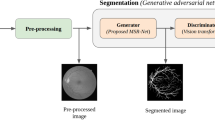Abstract
Since morphology of retinal blood vessels plays a key role in ophthalmological disease diagnosis, retinal vessel segmentation is an indispensable step for the screening and diagnosis of retinal diseases with fundus images. In this paper, deep convolution adversarial network combined with short connection and dense block is proposed to separate blood vessels from fundus image, named SUD-GAN. The generator adopts U-shape encode-decode structure and adds short connection block between convolution layers to prevent gradient dispersion caused by deep convolution network. The discriminator is all composed of convolution block, and dense connection structure is added to the middle part of the convolution network to strengthen the spread of features and enhance the network discrimination ability. The proposed method is evaluated on two publicly available databases, the DRIVE and STARE. The results show that the proposed method outperforms the state-of-the-art performance in sensitivity and specificity, which were 0.8340 and 0.9820, and 0.8334 and 0.9897 respectively on DRIVE and STARE, and can detect more tiny vessels and locate the edge of blood vessels more accurately.










Similar content being viewed by others
References
Soomro, T. A., Afifi, A. J., Zheng, L., Soomro, S., Gao, J., Hellwich, O., Paul, M. Deep learning models for retinal blood vessels segmentation: a review [J]. IEEE Access, 2019, 7(1):71696-71717. 1–1.
Azzopardi, G., Strisciuglio, N., Vento, M., Petkov, N. Trainable COSFIRE filters for vessel delineation with application to retinal images [J]. Med Image Anal, 2015,19(1): 46–57.
Zhao, Y., Rada, L., Chen, K., Harding, S. P., Zheng, Y. Automated vessel segmentation using infinite perimeter active contour model with hybrid region information with application to retinal images [J]. IEEE Trans Med Imaging, 2015,34(9):1797–1807.
Jiang, Z., Yepez, J., An, S., Ko, S. Fast, accurate and robust retinal vessel segmentation system [J]. Biocybern Biomed Eng, 2017, 37:412–421.
Liang E H. Retinal vascular segmentation based on improved matched filtering [J]. Inf Communication, 2018, 08:6-9.
J.I. Orlando, E. Prokofyeva, M.B. Blaschko, A discriminatively trained fully connected conditional random field model for blood vessel segmentation in fundus images [J], Trans Biomed Eng2017, 64 (1) , 16–27.
Fraz, M. M., Remagnino, P., Hoppe, A., Uyyanonvara, B., Rudnicka, A. R., Owen, C. G., Barman, S. A. An ensemble classification-based approach applied to retinal blood vessel segmentation [J]. IEEE Trans Biomed Eng, 2012,59(9): 2538–2548.
Shelhamer, E., Long, J., Darrell, T. Fully Convolutional Networks for Semantic Segmentation. arXiv preprint arXiv:1411.4038v3.
Ronneberger, O., Fischer, P., Brox, T. (2015).U-Net: Convolutional Networks for Biomedical Image Segmentation. Med Image Comp Comp-Assisted Interv—MICCAI 2015, 234–241.
Badrinarayanan, V., Kendall, A., Cipolla, R. SegNet: a Deep Convolutional Encoder-Decoder Architecture for Image Segmentation. arXiv preprint arXiv: 1511.00561v3
Mo, J., Zhang, L. Multi-level deep supervised networks for retinal vessel segmentation [J]. Int J Comput Assist Radiol Surg, 2017, 12(12), 2181–2193.
Hu, K., Zhang, Z., Niu, X., Zhang, Y., Cao, C., Xiao, F., Gao, X. (2018).Retinal vessel segmentation of color fundus images using multiscale convolutional neural network with an improved cross-entropy loss function. Neurocomputing, 309, 179–191.
Oliveira, A., Pereira, S., Silva, C. A. Retinal vessel segmentation based on fully convolutional Neural networks. Expert Syst Appl, 2018,112, 229–243.
Guo, S., Wang, K., Kang, H., Zhang, Y., Gao, Y., Li, T. BTS-DSN: deeply supervised neural network with short connections for retinal vessel segmentation. Int J Med Inform, 2019, 126:105–113.
Goodfellow I J, Pouget-Abadie J, Mirza M, et al. Generative adversarial nets [C], International Conference on Neural Information Processing Systems. MIT Press, 2014:2672-2680.
Mirza M, Osindero S. Conditional generative adversarial nets [J]. Comput Therm Sci, 2014: 2672-2680.
Radford A, Metz L, Chintala S. Unsupervised representation learning with deep convolutional generative adversarial networks. Comp Sci, 2015.
Moeskops P, Veta M, Lafarge M W, et al.. Adversarial training and dilated convolutions for brain MRI segmentation. Deep Learn Med Image Anal Multimodal Learn Clin Decis Support, 2017: 56-64, 2017
Rezaei M, Harmuth K, Gierke W, et al. A conditional adversarial network for semantic segmentation of brain tumor. Brain Lesion: Glioma, Multiple Sclerosis, Stroke and Traumatic Brain Injuries, 2018: 241-253, 2018
Shankaranarayana SM, Ram K, Mitra K, et al. Joint optic disc and cup segmentation using fully convolutional and adversarial networks. Fetal Infant Ophthalmic Med Image Anal, 2017:168-176, 2017
Lahiri A, Ayush K, Biswas P K, et al. Generative adversarial learning for reducing manual annotation in semantic segmentation on large scale miscroscopy images: automated vessel segmentation in retinal fundus image as test case. 2017 IEEE Conf Comp Vision Pattern Recog Workshops (CVPRW) Workshops (CVPRW), 2017:794-800, 2017
He K, Zhang X, Ren S, Sun J Deep residual learning for image recognition. 2016 IEEE Conference on Computer Vision and Pattern Recognition (CVPR), 2016
Huang G, Liu Z, van der Maaten L, Weinberger KQ (2017). Densely connected convolutional networks. 2017 IEEE Conference on Computer Vision and Pattern Recognition (CVPR)
Wu Chenyue, Yi Benshun, Zhang Yungang, Huang Song, Feng Yu. Image segmentation of retinal vessels based on improved convolutional neural network. Acta Opt Sin, 2018, 38(11):133-139.
Funding
The paper supported by key specialized research and development program of Henan Province (202102210170); Applied research plan of key scientific research projects in Henan colleges and Universities(19A510011).
Author information
Authors and Affiliations
Corresponding author
Additional information
Publisher’s Note
Springer Nature remains neutral with regard to jurisdictional claims in published maps and institutional affiliations.
Electronic Supplementary Material
ESM 1
(DOCX 12 kb)
Rights and permissions
About this article
Cite this article
Yang, T., Wu, T., Li, L. et al. SUD-GAN: Deep Convolution Generative Adversarial Network Combined with Short Connection and Dense Block for Retinal Vessel Segmentation. J Digit Imaging 33, 946–957 (2020). https://doi.org/10.1007/s10278-020-00339-9
Published:
Issue Date:
DOI: https://doi.org/10.1007/s10278-020-00339-9




